人力资源管理4(双语)
- 格式:ppt
- 大小:942.00 KB
- 文档页数:64
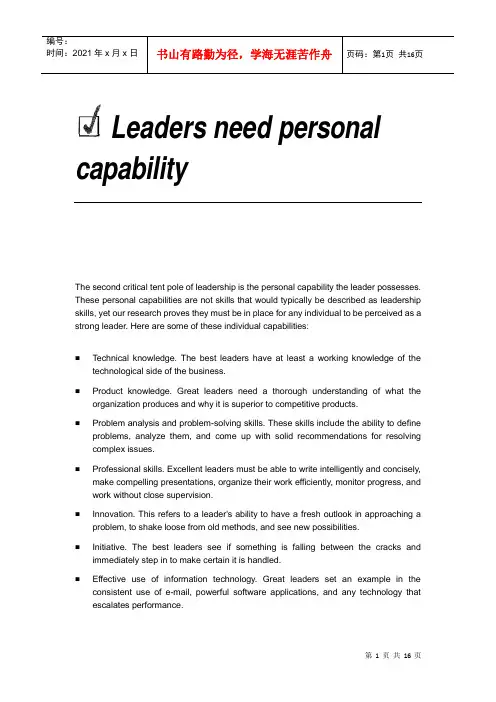
Leaders need personal capabilityThe second critical tent pole of leadership is the personal capability the leader possesses. These personal capabilities are not skills that would typically be described as leadership skills, yet our research proves they must be in place for any individual to be perceived as a strong leader. Here are some of these individual capabilities:⏹Technical knowledge. The best leaders have at least a working knowledge of thetechnological side of the business.⏹Product knowledge. Great leaders need a thorough understanding of what theorganization produces and why it is superior to competitive products.⏹Problem analysis and problem-solving skills. These skills include the ability to defineproblems, analyze them, and come up with solid recommendations for resolving complex issues.⏹Professional skills. Excellent leaders must be able to write intelligently and concisely,make compelling presentations, organize their work efficiently, monitor progress, and work without close supervision.⏹Innovation. This refers to a leader's ability to have a fresh outlook in approaching aproblem, to shake loose from old methods, and see new possibilities.⏹Initiative. The best leaders see if something is falling between the cracks andimmediately step in to make certain it is handled.⏹Effective use of information technology. Great leaders set an example in theconsistent use of e-mail, powerful software applications, and any technology that escalates performance.Career experts, Gene Dalton and Paul Thompson, explain that the most successful leaders progress through a series of four career stages, which cannot be skipped. Stage one is the time when individuals must prove they can learn the business and develop a solid foundation of technical expertise. In stage two, individuals continue to build technical skills and become independent contributors. By stage three, they become wentors-developing the careers and expertise of others. In stage four, they become organizational visionaries—leading the organization in new directions.Too often, leaders reach a position they've been seeking and start to coast—believing the learning phase of their career is over. They assume that there is a time for learning and a time for execution, and they are done learning. The best leaders never quit learning.Here are some techniques to maximize your personal capability:Understand the technology: Employees can see through attempts to cover up your lack of knowledge. Get up to speed by asking questions. Be willing to admit what you don't know.Perfect professional Skills: Managers can't manage unless they can communicate.Try new things: Great managers innovate and take initiative. They think outside the box and don't hesitate to experiment."Leadership cannot be delegated to others."—John H. Zenger and Joseph FolkmanFocus on resultsLeadership is ultimately about producing results. This is the third leadership tent pole. Leaders can have talent and character, but unless they produce sustained, impressive results for their organization, they simply are not good leaders.One study of 1000 managers showed that the best managers translate ideas into action. They push to take the next step forward by bringing energy, enthusiasm, and urgency to their role. They continually look for ways to improve. These leaders are in the driver's seat, with a foot on the accelerator—pressed to the floorboard most of the time.How do leaders focus on results? Extraordinary leaders do the following:⏹Establish stretch goals for their people.⏹Take personal responsibility for the outcomes of the group.⏹Provide ongoing feedback and coaching to their people.⏹Set lofty targets for the group to achieve.⏹Personally sponsor an initiative or action.⏹Initiate new programs, projects, processes, client relationships, or technology.⏹Focus on organization goals and ensure that they are translated into actions by theirdepartment.⏹Operate with speed and intensity; accelerate the pace of the group.⏹Champion the cause of the customer.⏹Balance long-term and short-term objectives.The best leaders get things accomplished, even under duress. They choose the right goals and follow through.These are some ways to bring about results:Know What the organization expects: Ask, "What does the organization expect from my department?" "From me personally?" The answers can be quite eye-opening.Stay fOCUSed On long-ternr results: We've all seen executives who can make earnings soar—temporarily. Extraordinary leaders resist the urge to sacrifice long-term for short-term results. They keep the welfare of the organization ahead of their own personal agendas.Take action: Extraordinary leaders wake up in the morning with a plan and put it into effect. They don't always wait for permission before moving ahead. Instead, they simply try new things."Leaders who aren't getting results aren't truly leading."—David Ulrich, Jack Zenger, and Norm SmallwoodCultivate interpersonal skillsThe fourth essential tent pole of leadership is interpersonal skills. Along with the central tent pole representing character, it probably holds the most canvas. This leadership skill has become more important over time, especially since the demise of the "command and control" styles of leadership. Of all the competencies, interpersonal skills seem to make the most difference in whether leaders are considered extraordinary.To develop strong interpersonal skills, leaders must do the following:Communicate powerfully and prolifically. Extraordinary leaders don't hoard new insights. They tell people! These leaders give their work group a sense of direction and purpose. They help people understand how their work contributes to the goals of the organization. They err on the side of telling people too much.Inspire others to high performance. Great leaders energize people to go the extra mile. They set stretch goals that motivate people to accomplish more than they think is possible.Build trust. Superstar leaders act so that others trust them. They balance their concern for productivity and results with sensitivity to employees' needs and problems. When conflicts arise, they deal with employees' feelings as well as the technical aspects of the issue. They stay approachable.Develop others. The most remarkable leaders support others' growth by giving honest and constructive feedback, balancing correc tive with positive evaluations. They stay tuned to what is happening in employees' careers. They let others grow, even if it means letting them leave the department.Collaborate and develop strong teams. Excellent leaders know not to insulate themselves from other team members and departments. They keep in touch, so thatcooperative urges beat out competitive urges. They cultivatetheir team members' ability to work with diverse people.Some key points for mastering people skills include:Involve Others in communication: One of the best ways to communicate is to get others to communicate! Interestingly, the worst communicators focus solely on getting their message across. The best communicators check people's reactions and get their ideas.Train everyone to be a leader: These days, leadership often gets passed around in a group. The person with the loftiest title and supposed power is no longer the one with all the answers. Believe that others are capable of great accomplishments and then watch them follow through.TO develop Others, develop yourself: The best leaders create space for their employees to move up from below by raising their own performance. Their efforts not only set the example, but also blaze a clear path for others to follow."If we treat people as they are, wemake them worse, but if we treat themas they ought to be, we help thembecome what they are capable ofbecoming."—Johann Wolfgang von GoetheLead organizational changeThe ability to lead organizational change is the fifth tent pole of extraordinary leadership. The best leaders inspire people to rally around a change, while poor leaders have to push, cajole, or even threaten employees to accept change. A turbulent business environment puts leaders to the test: excellent leaders can turn a significant change into a pleasant journey, while poorly led change might be better described as a "trip through hell." With most organizations today in a constant state of change—from dramatic growth to downsizing and restructuring—leaders must be able to skillfully shepherd organizations in new strategic directions.We're not talking about slight tactical shifts in current management processes or procedures. Caretaker managers can keep things going on a steady path. But if the organization is to rise to a significantly higher level of performance, extraordinary leaders must be able to sense the direction of the market and alter the fundamental business model. They must be able to envision and create a new organization culture.How do extraordinary leaders approach this task? The challenge in accomplishing change is not only to provide strong direction, but also to get people involved in making the change work. The most effective leaders are able to strike a balance between directing change and involving others.Leaders with strong directing tendencies are often prepared with well-organized plans that they communicate clearly. They maintain control, but sometimes end up with employees feeling that changes are being done to them but not with them. The end result is that employees resist change and start to distrust management.On the other hand, leaders who favor involving others in change sometimes fail to provide enough direction, leaving employees confused about their roles and what they need to do to keep the change moving forward. Sometimes leaders who tend toward involving others are simply unwilling to take risks or make tough decisions.Our research shows clearly that both sets of behaviors are necessary for a leader to manage change effectively. Leaders need to help their people understand the specific details of the change and also help them feel involved so they will feel committed to the change.Leading organizational change requires that you:Create the Overarching Vision:Using your knowledge of the external environment, determine which trends to pursue and which to ignore. Stay involved in critical decisions. Use your influence to shape their outcome.Translate the vision into specific objectives: In order to make the strategic vision happen, break it down to the level of specific tasks and expectations for individual workers. It is up to you to determine how resources will be allocated. You must establish the norms that will shape the culture.Balance the need for direction with the need to involve others: Build support for your vision by getting people on board."Some people grin and bear it. Others smile and change it."—Unknown领导者需要个人能力领导能力中第二根重要的支杆是领导者所拥有的个人能力。

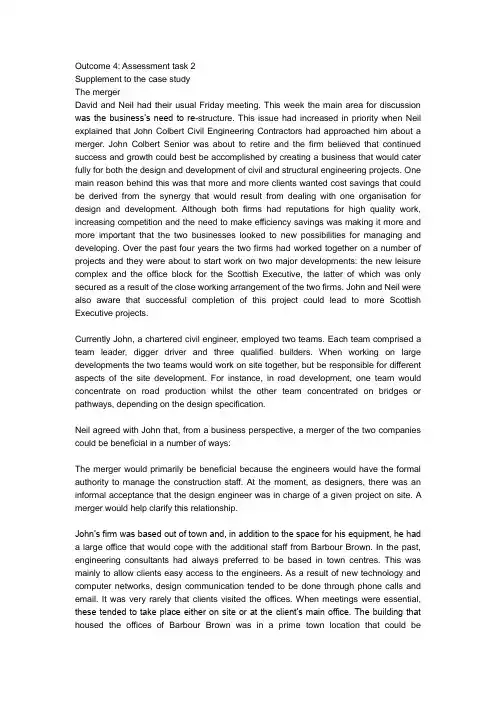
Outcome 4: Assessment task 2Supplement to the case studyThe mergerDavid and Neil had their usual Friday meeting. This week the main area for discussion was the business’s need to re-structure. This issue had increased in priority when Neil explained that John Colbert Civil Engineering Contractors had approached him about a merger. John Colbert Senior was about to retire and the firm believed that continued success and growth could best be accomplished by creating a business that would cater fully for both the design and development of civil and structural engineering projects. One main reason behind this was that more and more clients wanted cost savings that could be derived from the synergy that would result from dealing with one organisation for design and development. Although both firms had reputations for high quality work, increasing competition and the need to make efficiency savings was making it more and more important that the two businesses looked to new possibilities for managing and developing. Over the past four years the two firms had worked together on a number of projects and they were about to start work on two major developments: the new leisure complex and the office block for the Scottish Executive, the latter of which was only secured as a result of the close working arrangement of the two firms. John and Neil were also aware that successful completion of this project could lead to more Scottish Executive projects.Currently John, a chartered civil engineer, employed two teams. Each team comprised a team leader, digger driver and three qualified builders. When working on large developments the two teams would work on site together, but be responsible for different aspects of the site development. For instance, in road development, one team would concentrate on road production whilst the other team concentrated on bridges or pathways, depending on the design specification.Neil agreed with John that, from a business perspective, a merger of the two companies could be beneficial in a number of ways:The merger would primarily be beneficial because the engineers would have the formal authority to manage the construction staff. At the moment, as designers, there was an informal acceptance that the design engineer was in charge of a given project on site. A merger would help clarify this relationship.John’s firm was based out of town and, in addition to the space for his equipment, he had a large office that would cope with the additional staff from Barbour Brown. In the past, engineering consultants had always preferred to be based in town centres. This was mainly to allow clients easy access to the engineers. As a result of new technology and computer networks, design communication tended to be done through phone calls and email. It was very rarely that clients visited the offices. When meetings were essential, these tended to take place either on site or at the client’s main office. The building that housed the offices of Barbour Brown was in a prime town location that could beredeveloped. Aware of this potential, Neil was eager to give the merger his full consideration.In addition to the re-location, John also has a small, but efficient, administration team that handles reception, secretarial support, accounts and wages. Again, savings could be made by reducing the administration costs currently incurred by having two administration sections. Neil was aware that the merger, should it go ahead, would create some redundancies.Although not always keen to make major changes, David did agree that, since their business needed re-structured, the merger would provide the ideal reason for making changes to the current method of working, and the proposal to merge should go ahead.David and Neil星期五都有例会。
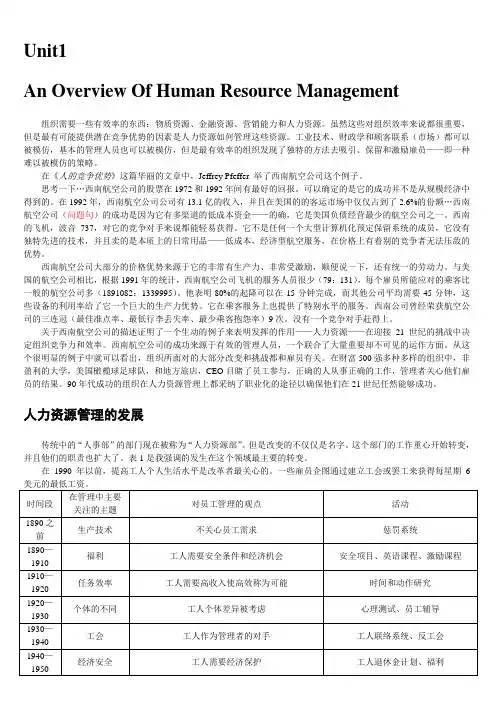
Unit1An Overview Of Human Resource Management组织需要一些有效率的东西:物质资源、金融资源、营销能力和人力资源。
虽然这些对组织效率来说都很重要,但是最有可能提供潜在竞争优势的因素是人力资源如何管理这些资源。
工业技术、财政学和顾客联系(市场)都可以被模仿,基本的管理人员也可以被模仿,但是最有效率的组织发现了独特的方法去吸引、保留和激励雇员——即一种难以被模仿的策略。
在《人的竞争优势》这篇华丽的文章中,Jeffrey Pfeffer 举了西南航空公司这个例子。
思考一下…西南航空公司的股票在1972和1992年间有最好的回报。
可以确定的是它的成功并不是从规模经济中得到的。
在1992年,西南航空公司公司有13.1亿的收入,并且在美国的的客运市场中仅仅占到了2.6%的份额…西南航空公司(问题句)的成功是因为它有多渠道的低成本资金——的确,它是美国负债经营最少的航空公司之一。
西南的飞机,波音737,对它的竞争对手来说都能轻易获得。
它不是任何一个大型计算机化预定保留系统的成员,它没有独特先进的技术,并且卖的是本质上的日常用品——低成本,经济型航空服务,在价格上有着别的竞争者无法压敌的优势。
西南航空公司大部分的价格优势来源于它的非常有生产力、非常受激励,顺便说一下,还有统一的劳动力。
与美国的航空公司相比,根据1991年的统计,西南航空公司飞机的服务人员很少(79:131),每个雇员所能应对的乘客比一般的航空公司多(1891082:1339995)。
他表明80%的起降可以在15分钟完成,而其他公司平均需要45分钟,这些设备的利用率给了它一个巨大的生产力优势。
它在乘客服务上也提供了特别水平的服务。
西南公司曾经荣获航空公司的三连冠(最佳准点率、最低行李丢失率、最少乘客抱怨率)9次。
没有一个竞争对手赶得上。
关于西南航空公司的描述证明了一个生动的例子来表明发挥的作用——人力资源——在迎接21世纪的挑战中决定组织竞争力和效率。
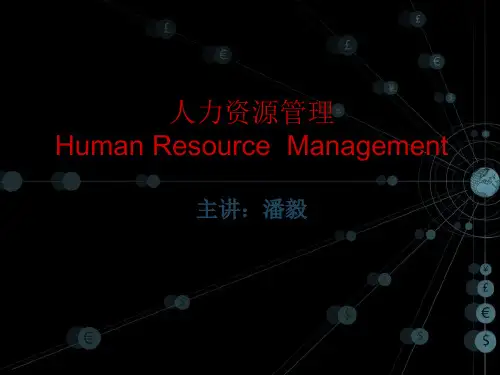
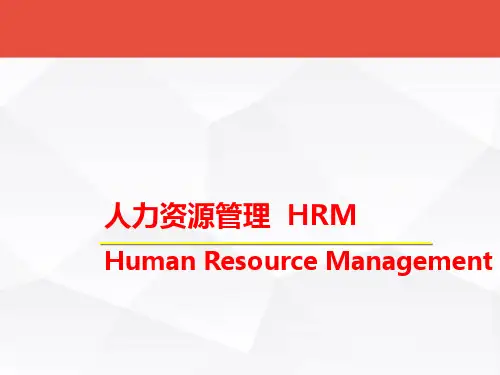

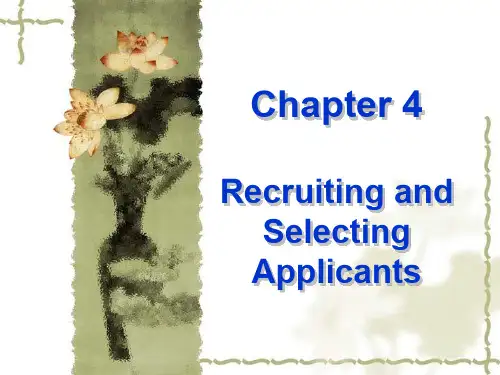
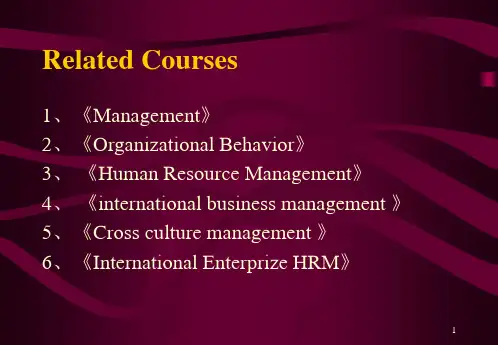
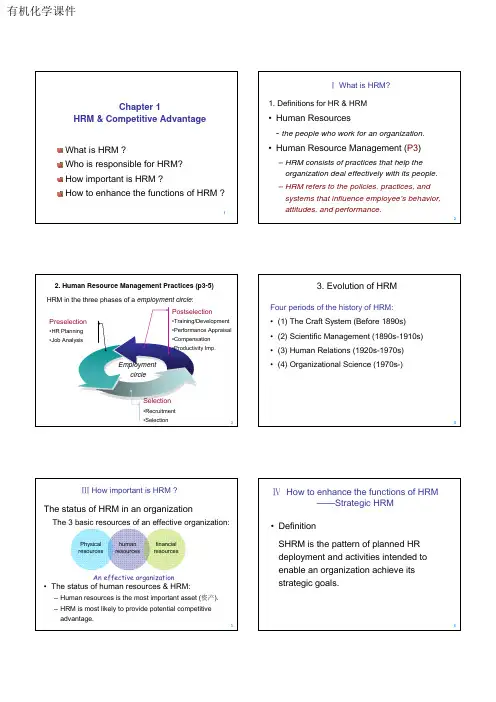
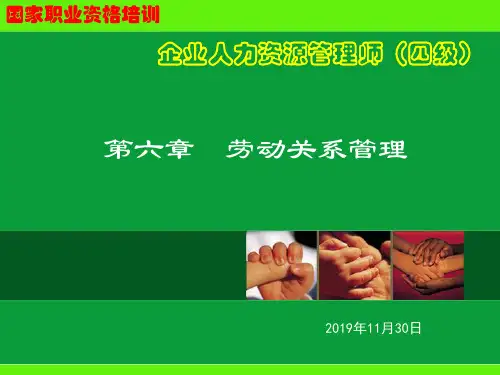
国家职业资格培训教程-——人力资源管理师(四级)第一章人力资源规划人力资源规划的总目标是确保企业各类工作岗位在适当的时机,获得适当的人员(包括数量、质量、层次和结构等),实现人力资源的最佳配置,最大限度地开发和利用人力资源潜力,有效地激励员工,保持智力资本的竞争优势。
第一节企业组织信息的采集与处理第一单元组织信息的采集一、人力资源规划的概述(一)人力资源的内涵(广义)是企业所有的人力资源计划的总称,是战略规划与战术计划,即具体的实施计划的统一;(狭义)是指为实施企业的发展战略,完成企业的生产经营目标,根据企业内外环境和条件的变化,运用科学的方法对企业人力资源的需求和供给进行预测,制定相宜的政策和措施,从而使企业人力资源供给和需求达到平衡,实现人力资源合理配置,有效激励员工的过程。
长期规划(五年及以上的计划)、短期计划(一年以内的计划)、介于两者之间的为中期计划。
(二)人力资源规划的内容1、战略规划。
是对企业人力资源开发和利用的大政方针、政策和策略的规定,是各种人力资源具体计划的核心,是事关全局的关键性规划2、组织规划。
是对企业整体框架的设计,包括组织信息的采集、处理和应用,组织结构图的绘制,组织调查、诊断和评价,组织设计与调整,以及组织机构的设置等。
3、企业人力资源管理制度规划。
是人力资源总规划目标实现的重要保证,包括人力资源管理制度建设的程序、制度化管理等。
4、人员规划。
是对企业人员总量、构成、流动的整体规划,包括人力资源现状分析、企业定员、人员需求与供给预测、人员供需平衡等。
5、人力资源费用计划。
费用计划是对企业人工成本、人力资源管理费用的整体规划,包括人力资源费用预算、核算、审核、结算,以及人力资源费用控制等。
二、企业信息采集和处理的基本原则。
1、准确性原则2、系统性原则3、针对性原则4、及时性原则5、适用性原则6、经济性原则【能力要求】一、企业组织信息采集的程序(一)调研准备阶段1、初步情况分析。
Individual ReportF84T 34 Managing People and OrganisationsOutcome 4NAME:SCN:CLASS:ContentsIntroduction (2)Section 1:The Structure at Present in Shangri-la Hotel (2)Section 2:An Appropriate Form of Re-Structure for Shangri-la Hotel (4)Section 3:The Influence of Task, Technology, and Size on the New Structure (5)Section 4: Line, Staff ,Functional and Lateral relationships within the New Structure (6)Section 5: Authority, Responsibility and Delegation within the New Structure (7)Conclusion (8)Reference (8)IntroductionThe purpose of this report is to examine the understanding of management structure in the organization and its application. There are five sections in the report: management structure before merger; management structure after new development; contingency approach and its variables after merger; different relationships within the new structure; relevance of different relationships with new structure.Section 1:The Structure at Present in Shangri-la HotelAt present, flat structure is used in the management of the hotel. Hybrid management structure is used. Craig used the centralized and line approach to manage the restaurant .Ailsa used the decentralized and team approach to manage the hotel. In the hotel, all of the work was divided into four types according to different products or services: chambermaids, reception, kitchen staff and waiting staff.Flat structure: it means that a business has few vertical level of management and a wide span of control. As a result, the relationship between manager and subordinate will be closed, the flow of information will be quick, and it will save administrative expenses. However, because of wide spans, the communication between the same level department and employees will be difficult. In the case, for example, in the kitchen, there were only two levels: Craig, the manager; kitchen staffs and waiters. Craig directly gave the subordinates their different tasks. So it was a flat structure.Centralization& Decentralization: the centralization means that the important decisions are taken by the top management and the other levels implement the directions that top manager gives. In the case, Craig mainly used the centralized approach. For example, all his subordinates must follow the menu made by Craig.And Craig made decisions by himself and allocated tasks to kitchen staff and waiters. It should be a centralized approach. Decentralization means top manager delegates authorities to all levels of management. In the case, Ailsa used this decentralized approach. For example, in the management of Ailsa, she gave rights to Antonio to run things. It was a decentralized approach.Line structure: it means that authority comes down from the boss to their staff directly in a line relationship. Its advantage is that it is very convenient to communicate because of the direct line relationship. However, because it needs an one-to-one managing process, the managing tasks are too heavy. It will be costly. In this case, Craig used the line approach. Craig allocated specific tasks to different staffs. He required that all staffs should do dishes following his menu. And he required the waiters should attend to customers within five minutes of being seated. He managed all the individuals in the restaurant directly. So it was a line approach.Team structure: it refers to divide the entire organization into work groups or teams. After dividing into teams, there will be high employee involvement and empowerment. The functional barriers will also be reduced. However, the ambiguous chain of command will arise. In the case, Ailsa used this approach. She divided all staffs in the hotel into several teams, such as the reception team managed by Antonio, the cleaning staff team, and the chambermaids team. Every team had their own specific work to do, and every team number involves in the management. So it was a team approach.Product or service: it means that the entire organization is divided into different departments according to the products or service supplied to customers. In the case, is was divided into four types: chambermaids, reception, kitchen staff and waiting staff. For example, in the management of the hotel, Craig’s staffs were divided into following parts: the kitchen cook, the purchasing staff and the waiters. They did different tasks and made different products or service to customers. So it was a products or service approach.Section 2:An Appropriate Form of Re-Structure for Shangri-la HotelAfter the new development of the organization, the organizational structure can be divided into three parts: the manager, the staff and the supplier. It is called a Shamrock management structure. The departmentalization approach could also be used.Product departmentalization: it means that the entire organization is divided into different departments according to the products or service supplied to customers. In the case, before merger, it consists of four types: chambermaids, reception, kitchen staff and waiting staff. There would be additional two types after the merger. One was is farm , the other is Gordon’s restaurant.Shamrock structure: It especially refers to the three-part or three levels of an organizational structure. In the shamrock organization there are three different groups of people: basic managers, employees as the core part, the external co- workers and the part-time workers as a form of supplement.As above graph shows, the organization of the hotel was divided into three parts in the Shamrock model. The first part was the manager in the organization. This part played an important role in the organization. In the case, Craig was a manager who directs the tasks in the kitchen and the restaurant. He arranged and managed the kitchen and restaurant into a normal operation. Ailsa played a key role in the marketing and management of the hotel. She worked hard in the managing hotel development and made great progress finally. The second part was staff. There were four types : chambermaids, reception, kitchen staff and waiting staff. They also played an important role in the operating activities of the hotel. The chambermaids and waiting staffs provided service to customers and the kitchen supplied foods and drinks to customers. The third part was supplier- Gordon. Gordon supplied raw materials from his farm to Craig’s kitchen. Also, Gordon opened a restaurant which consisted of his wife, two chefs and four waiters. Every part in the Shamrock organization has their own expectations.Section 3:The Influence of Task, Technology, and Size on the New StructureContingency theory holds the view that there is no one best way to structure. The particular situational factors such as size, technology or task will determine the systems and structures employed.Task: it means that the nature and size of the task will influence shaping the organization. For example, in the case, before Gordon converted his farm house to his restaurant, his main task was to grow and sell organic products. So the organization was a simple one. After owning a restaurant, the tasks became complicated and the organization structure became complicated as well. So the nature and size of the task will determine the type of the organization structure.Technology: Technology relates to the production process used. It is not just related to the information technology, but also to the technology of producing a product or supplying service. In this case, before the merger of Gordon’s farm as a hotel, Ailsa made marketing strategies and plans which focused on the city customersand business. After the merger, Ailsa must make another different marketing strategy which should be feasible in Gordon’s farm. Appropriate technology is very important in the operating process of an organization.Size: It is an essential factor that influences the shape and structure of an organization. Also, different size of organizations have different producing procedures and outcomes. In the case, after the merger, the hotel had a lot of changes in the size. For example, the number of stuff was increasing. Besides, because Gordon’s farm was a part of the hotel, it would be less costly to buy raw materials used in the kitchen. It would a competitive advantage in price within its competitors.Section 4: Line, Staff ,Functional and Lateral relationships within the New StructureLine relationship: it means that authority comes down from the boss to their staff directly in a line relationship. In the case, Craig was responsible for managing and directing the kitchen staff and waiters. He allocated the specific tasks to different staffs to ensure that his plans were completed. This was an example of the line relationship.Staff relationship: It means the relationship between the staffs in different departments. For example, in the case, the relationship between reception staff and other staffs, such as the maintenance staff.Functional relationship: It is a relationship which exists between different functions in the hotel. In the case, for example, the relationship between the accountant function and other functions. They all had closed relationship in the organization.Lateral relationship: It is a relationship which exists between the same level of staffs which are in different systems and do different tasks. For example, there were waiters in both Ailsa’s and Craig’s management system. But waiters in Craig’s restaurant supplied service to customers eating here. And waiters in Ailsa’s hotel supplied service to customers living here. This was a lateral relationship.Section 5: Authority, Responsibility and Delegation within the New StructureAuthority: It is a right to order or direct others to do specific tasks, and then attract the responses which are appropriate to achieve the goals of the organization. For example, in the case, only Craig had the authority to allocate tasks to his staffs. And only Craig and Saskia had the right to sign for any procedure. Few changes appeared after the merger.Responsibility:It is the obligation for some people in the organization to perform a task, assignment or function. In the case, for example, Antonio as a reception manager, had the responsibility on reception of clients. Few changes appeared after the merger.Delegation: It is an action to pass the responsibility or authority to a person to carry out and complete the specific task. In the case, Ailsa delegated her right to Antonio to help her manage the hotel. However, Craig hardly delegated any right to others. As a result, it caused some problems such as staffs’complaints. The suggestion is that Craig should delegate some rights to the staff, such as some decision-making. In this way, the involvement of the staffs will be increased. And the efficiency of kitchen operation will be improved.ConclusionThe findings of the report reveal the management structures, contingency theory and different relationships and their applications in different situations.ReferenceYuan Yu, Zhang Shutao,2013,Managing People and Organisations, China Modern Economic Publishing House.高考是我们人生中重要的阶段,我们要学会给高三的自己加油打气。
目录目录 (1)第一篇绪论 (2)第一章HRM and 竞争优势 (2)1.理解一个公司的人力资源管理实践的本质: (2)2.理解直线经理和人力资源专业人员在人力资源管理过程当中角色的异同: (2)3.理解什么是竞争优势,企业怎么才能实现竞争优势。
(2)4.理解人力资源实践怎样帮助企业实现竞争优势。
(2)5.理解为什么通过人力资源实践中获得的竞争优势可以保持。
(2)第二篇人力资源挑选前的实践 (3)第二章人力资源规划 (3)1. 理解人力资源规划怎样促进一个企业的竞争优势的。
(3)2.解释一个企业致力于战略规划的原因和方法。
(3)3.解释人力资源计划活动开展的原因和方法。
(3)4.描述人力资源管理实践是如何回应人力资源计划的。
(3)第三章工作分析 (3)1. 讨论工作分析这一人力资源管理实践如何给竞争优势建立了基础。
(4)2.说明一个组织是如何开展工作分析的。
(4)第三篇人力资源挑选实践 (4)第四章招聘求职者 (4)1. 理解公司的招聘实践是如何提高企业的竞争优势的。
(4)2.讨论不同的招聘方法。
(4)第五章挑选求职者 (6)1. 描述一下当考虑到雇员选择时效度的意义和企业如何实现并整理效度。
(6)2.说明公司运用的不同的挑选方法。
(6)第四篇人力资源挑选后的实践 (7)第六章雇员的培训和开发 (7)1. 理解为什么有效的培训和开发可以提高企业的竞争优势。
(7)2.描述管理成功计划中包括的步骤。
(7)3.描述在管理开发项目中不同的培训方式。
(7)第七章雇员的工作绩效评估 (8)1. 理解有效的绩效考评系统怎样加强了企业的竞争优势。
(8)2.描述不同的考评工具。
(8)3. 说明企业如何开发一个绩效考评系统。
(9)第八章确定薪酬和福利 (9)1. 解释有效的薪酬系统如何加强企业的竞争优势。
(9)提高了成本效率; (9)实现了合法的承诺; (9)加强了招聘成功的效果并减少了离职率。